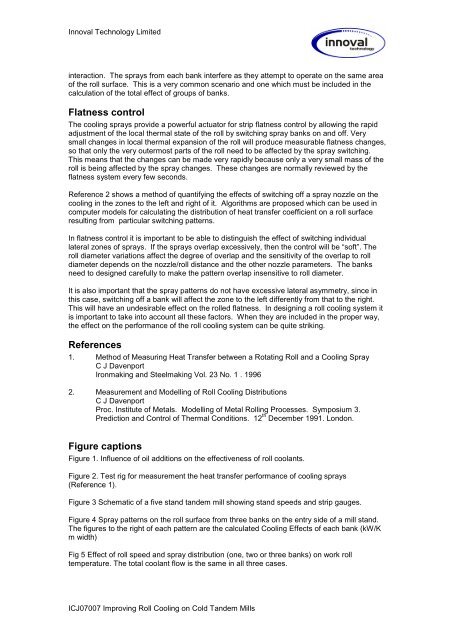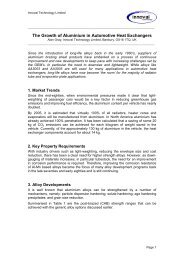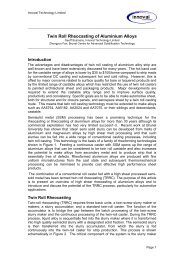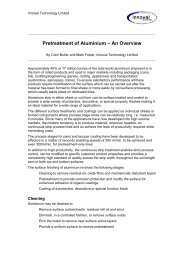Improving Roll Cooling on Cold Tandem Mills - Innoval Technology ...
Improving Roll Cooling on Cold Tandem Mills - Innoval Technology ...
Improving Roll Cooling on Cold Tandem Mills - Innoval Technology ...
Create successful ePaper yourself
Turn your PDF publications into a flip-book with our unique Google optimized e-Paper software.
<strong>Innoval</strong> <strong>Technology</strong> Limited<br />
interacti<strong>on</strong>. The sprays from each bank interfere as they attempt to operate <strong>on</strong> the same area<br />
of the roll surface. This is a very comm<strong>on</strong> scenario and <strong>on</strong>e which must be included in the<br />
calculati<strong>on</strong> of the total effect of groups of banks.<br />
Flatness c<strong>on</strong>trol<br />
The cooling sprays provide a powerful actuator for strip flatness c<strong>on</strong>trol by allowing the rapid<br />
adjustment of the local thermal state of the roll by switching spray banks <strong>on</strong> and off. Very<br />
small changes in local thermal expansi<strong>on</strong> of the roll will produce measurable flatness changes,<br />
so that <strong>on</strong>ly the very outermost parts of the roll need to be affected by the spray switching.<br />
This means that the changes can be made very rapidly because <strong>on</strong>ly a very small mass of the<br />
roll is being affected by the spray changes. These changes are normally reviewed by the<br />
flatness system every few sec<strong>on</strong>ds.<br />
Reference 2 shows a method of quantifying the effects of switching off a spray nozzle <strong>on</strong> the<br />
cooling in the z<strong>on</strong>es to the left and right of it. Algorithms are proposed which can be used in<br />
computer models for calculating the distributi<strong>on</strong> of heat transfer coefficient <strong>on</strong> a roll surface<br />
resulting from particular switching patterns.<br />
In flatness c<strong>on</strong>trol it is important to be able to distinguish the effect of switching individual<br />
lateral z<strong>on</strong>es of sprays. If the sprays overlap excessively, then the c<strong>on</strong>trol will be “soft”. The<br />
roll diameter variati<strong>on</strong>s affect the degree of overlap and the sensitivity of the overlap to roll<br />
diameter depends <strong>on</strong> the nozzle/roll distance and the other nozzle parameters. The banks<br />
need to designed carefully to make the pattern overlap insensitive to roll diameter.<br />
It is also important that the spray patterns do not have excessive lateral asymmetry, since in<br />
this case, switching off a bank will affect the z<strong>on</strong>e to the left differently from that to the right.<br />
This will have an undesirable effect <strong>on</strong> the rolled flatness. In designing a roll cooling system it<br />
is important to take into account all these factors. When they are included in the proper way,<br />
the effect <strong>on</strong> the performance of the roll cooling system can be quite striking.<br />
References<br />
1. Method of Measuring Heat Transfer between a Rotating <str<strong>on</strong>g>Roll</str<strong>on</strong>g> and a <str<strong>on</strong>g>Cooling</str<strong>on</strong>g> Spray<br />
C J Davenport<br />
Ir<strong>on</strong>making and Steelmaking Vol. 23 No. 1 . 1996<br />
2. Measurement and Modelling of <str<strong>on</strong>g>Roll</str<strong>on</strong>g> <str<strong>on</strong>g>Cooling</str<strong>on</strong>g> Distributi<strong>on</strong>s<br />
C J Davenport<br />
Proc. Institute of Metals. Modelling of Metal <str<strong>on</strong>g>Roll</str<strong>on</strong>g>ing Processes. Symposium 3.<br />
Predicti<strong>on</strong> and C<strong>on</strong>trol of Thermal C<strong>on</strong>diti<strong>on</strong>s. 12 th December 1991. L<strong>on</strong>d<strong>on</strong>.<br />
Figure capti<strong>on</strong>s<br />
Figure 1. Influence of oil additi<strong>on</strong>s <strong>on</strong> the effectiveness of roll coolants.<br />
Figure 2. Test rig for measurement the heat transfer performance of cooling sprays<br />
(Reference 1).<br />
Figure 3 Schematic of a five stand tandem mill showing stand speeds and strip gauges.<br />
Figure 4 Spray patterns <strong>on</strong> the roll surface from three banks <strong>on</strong> the entry side of a mill stand.<br />
The figures to the right of each pattern are the calculated <str<strong>on</strong>g>Cooling</str<strong>on</strong>g> Effects of each bank (kW/K<br />
m width)<br />
Fig 5 Effect of roll speed and spray distributi<strong>on</strong> (<strong>on</strong>e, two or three banks) <strong>on</strong> work roll<br />
temperature. The total coolant flow is the same in all three cases.<br />
ICJ07007 <str<strong>on</strong>g>Improving</str<strong>on</strong>g> <str<strong>on</strong>g>Roll</str<strong>on</strong>g> <str<strong>on</strong>g>Cooling</str<strong>on</strong>g> <strong>on</strong> <strong>Cold</strong> <strong>Tandem</strong> <strong>Mills</strong>
















